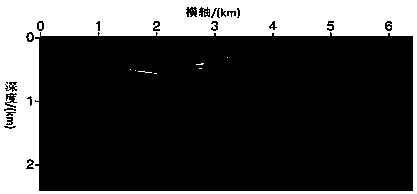Reflected wave waveform inversion method based on phase correction
A technology for phase correction and waveform inversion, applied in measurement devices, instruments, scientific instruments, etc., can solve problems such as phase inversion winding, and achieve the effects of improving linearity, high global convergence, and reducing dependence.
- Summary
- Abstract
- Description
- Claims
- Application Information
AI Technical Summary
Problems solved by technology
Method used
Image
Examples
Embodiment 1
[0055] Example 1. A method for inversion of reflected wave waveform based on corrected phase, the method comprises the following steps:
[0056] Step 1: Use the envelope information of the seismic data to correct the expression of the phase, and obtain the corrected phase information of the seismic data;
[0057] Step 2: Define the target functional expression of the reflected wave waveform inversion based on the corrected phase information, and use the adjoint state method to obtain the gradient expression of the target functional with respect to the model;
[0058] Step 3: Use the obtained gradient to update the model background field to obtain the accurate model background field of the travel time information, so as to ensure the accuracy of the travel time information;
[0059] Step 4: Finally, use the accurate model background field obtained from the travel time information to do conventional full waveform inversion to obtain high-precision velocity field modeling result...
Embodiment 2
[0085] Example 2. A method of reflected wave waveform inversion based on modified phase. This method first proposes a modified phase inversion method, which uses the envelope information of seismic data to effectively avoid the winding problem of traditional phase inversion; then the modified phase The inversion method is combined with the RFWI method to define the corresponding target functional, and the adjoint equation form of the target functional is obtained by using the adjoint state method; The gradient of the target functional with respect to the model; use optimization methods, such as gradient methods, to update the background field of the model to ensure the accuracy of travel time information; finally, the obtained background velocity field is used as the input initial velocity field of traditional waveform inversion, Finely characterize the details of the model to obtain a high-precision subsurface velocity model.
[0086] Specifically include the following steps...
PUM
 Login to View More
Login to View More Abstract
Description
Claims
Application Information
 Login to View More
Login to View More - R&D
- Intellectual Property
- Life Sciences
- Materials
- Tech Scout
- Unparalleled Data Quality
- Higher Quality Content
- 60% Fewer Hallucinations
Browse by: Latest US Patents, China's latest patents, Technical Efficacy Thesaurus, Application Domain, Technology Topic, Popular Technical Reports.
© 2025 PatSnap. All rights reserved.Legal|Privacy policy|Modern Slavery Act Transparency Statement|Sitemap|About US| Contact US: help@patsnap.com



